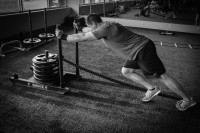Structure of a Strength Workout
Selecting a workout format that corresponds with your goals is a key component of designing an effective exercise program. Someone whose aim is to put on mass is simply not going to lift weights identically to someone who wants to lose weight and tone up. The choices you make in the weight room, from the number of repetitions to how long you rest, will determine your results. Before you begin a strength-training program, ask yourself the following questions:
How Many Repetitions Should I Do?
Choosing the appropriate number of repetitions is the most important step in making sure your workouts fit your goals. Repetitions, after all, determine the amount of weight to be lifted. If your goal is to build muscle mass, then you’ll aim to complete 5-8 reps per set and as such will select relatively heavy weights (80-plus percent of your one rep max on a given exercise).
If your goal is to build strength and mild hypertrophy (slight increase in size) as well as lose weight, 8-12 repetitions per set is a suitable range. This will ensure you put on enough lean mass to increase metabolism and aid fat loss. In fact, those focused on weight loss may complete as many as 15 reps as long as they are choosing weights heavy enough to get to fatigue within this range. This means that unless you’re over 60, recuperating from an injury, very obese, or very weak from a sedentary lifestyle, those little 5-lb dumbbells won’t cut it.
If your goal is to increase muscle endurance (great for those training for distance events as well as for people over 60 or recovering from injury), shoot for 15-20 reps per set, which helps your body better adapt to sustaining loads over time.
How Many Sets Should I Do?
As a general rule, the fewer reps you do the more sets you need to complete. For those performing 5-8 reps, you’ll need to do 4-6 sets to build mass. Those in the 8-12-rep range should aim for 3-4 sets. 12-15 reps require 2-3 sets, while 15-plus reps only call for two sets. Individual needs may vary, and the number of sets may also depend on exercise selection, so when in doubt consult a fitness professional.
How Long Should I Rest Between Sets?
Again, the heavier the weight lifted (and thus the fewer reps), the longer the recovery. This means that mass-builders should give themselves 90-120 seconds of rest between sets, while those in the 8-12 rep range can benefit from 60-90 seconds. Individuals completing more than 12 repetitions should keep their rest periods under a minute, while those with a goal of increased endurance can drop their rests to 30 seconds.
A note about weight loss: rest periods under 60 seconds have been shown to increase production of growth hormone, a primary agent of lipolysis (fat-burning) during and after high-intensity strength training. Those looking to reduce body fat, therefore, should consider performing exercises in small circuits (2-4 exercises) of opposing or unrelated muscle groups. An example would be rows paired with push-ups, or lunges followed by shoulder presses followed by planks. This will allow for briefer rest intervals (i.e. 30 seconds) between sets, with as much as 60 seconds between circuits, while still allowing for adequate rest of individual muscle groups.
A final factor to consider is tempo, or the time your muscles spend under tension with each individual repetition. Expert recommendations vary; however, slower is generally better, as you’ll maximize control of the weight lifted and minimize momentum. Whatever the pace you choose, consider taking longer on the eccentric (lowering or deceleration) phase than you do on the concentric (lifting or contracting) half of the movement: 2-4 seconds to lower the weight or your body, and 1-2 seconds to lift.
buy steroids needles uk
4725 total views, 2 today






